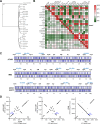Comparative analysis of Porphyromonas gingivalis A7436 and ATCC 33277 strains reveals differences in the expression of heme acquisition systems
- PMID: 38289063
- PMCID: PMC10913741
- DOI: 10.1128/spectrum.02865-23
Comparative analysis of Porphyromonas gingivalis A7436 and ATCC 33277 strains reveals differences in the expression of heme acquisition systems
Abstract
Porphyromonas gingivalis strains exhibit different phenotypes in vitro, different virulence potential in animal models, and different associations with human diseases, with strains classified as virulent/more virulent (e.g., A7436 and W83) or as less virulent/avirulent (e.g., ATCC 33277). In this study, we comparatively analyzed the A7436 and ATCC 33277 strains to better understand their variability. Global gene expression analysis in response to heme and iron limitation revealed more pronounced differences in the A7436 than in the ATCC 33277 strain; however, in both strains, the largest changes were observed in genes encoding hypothetical proteins, genes whose products participate in energy metabolism, and in genes encoding proteins engaged in transport and binding proteins. Our results confirmed that variability between P. gingivalis strains is due to differences in the arrangement of their genomes. Analysis of gene expression of heme acquisition systems demonstrated that not only the availability of iron and heme in the external environment but also the ability to store iron intracellularly can influence the P. gingivalis phenotype. Therefore, we assume that differences in virulence potential may also be due to differences in the production of systems involved in iron and heme acquisition, mainly the Hmu system. In addition, our study showed that hemoglobin, in a concentration-dependent manner, differentially influences the virulence potential of P. gingivalis strains. We conclude that iron and heme homeostasis may add to the variability observed between P. gingivalis strains.
Importance: Periodontitis belongs to a group of multifactorial diseases, characterized by inflammation and destruction of tooth-supporting tissues. P. gingivalis is one of the most important microbial factors involved in the initiation and progression of periodontitis. To survive in the host, the bacterium must acquire heme as a source of iron and protoporphyrin IX. P. gingivalis strains respond differently to changing iron and heme concentrations, which may be due to differences in the expression of systems involved in iron and heme acquisition. The ability to accumulate iron intracellularly, being different in more and less virulent P. gingivalis strains, may influence their phenotypes, production of virulence factors (including proteins engaged in heme acquisition), and virulence potential of this bacterium.
Keywords: HmuY; IhtB; Porphyromonas gingivalis; gingipain; heme; heme acquisition; hemoglobin; iron; strain variation; virulence.
Conflict of interest statement
The authors declare no conflict of interest.
Figures






Similar articles
-
Defining the role of Hmu and Hus systems in Porphyromonas gingivalis heme and iron homeostasis and virulence.Sci Rep. 2024 Dec 28;14(1):31156. doi: 10.1038/s41598-024-82326-6. Sci Rep. 2024. PMID: 39730829 Free PMC article.
-
PgFur participates differentially in expression of virulence factors in more virulent A7436 and less virulent ATCC 33277 Porphyromonas gingivalis strains.BMC Microbiol. 2019 Jun 11;19(1):127. doi: 10.1186/s12866-019-1511-x. BMC Microbiol. 2019. PMID: 31185896 Free PMC article.
-
Interplay between Porphyromonas gingivalis Hemophore-Like Protein HmuY and Kgp/RgpA Gingipains Plays a Superior Role in Heme Supply.Microbiol Spectr. 2023 Feb 8;11(2):e0459322. doi: 10.1128/spectrum.04593-22. Online ahead of print. Microbiol Spectr. 2023. PMID: 36752645 Free PMC article.
-
Iron and heme utilization in Porphyromonas gingivalis.FEMS Microbiol Rev. 2005 Jan;29(1):119-44. doi: 10.1016/j.femsre.2004.09.001. FEMS Microbiol Rev. 2005. PMID: 15652979 Review.
-
Heme acquisition mechanisms of Porphyromonas gingivalis - strategies used in a polymicrobial community in a heme-limited host environment.Mol Oral Microbiol. 2017 Feb;32(1):1-23. doi: 10.1111/omi.12149. Epub 2016 Jan 28. Mol Oral Microbiol. 2017. PMID: 26662717 Review.
Cited by
-
HemN2 Regulates the Virulence of Pseudomonas donghuensis HYS through 7-Hydroxytropolone Synthesis and Oxidative Stress.Biology (Basel). 2024 May 24;13(6):373. doi: 10.3390/biology13060373. Biology (Basel). 2024. PMID: 38927253 Free PMC article.
-
In-vitro effect of different instrumentations on adhesion of a multispecies bacterial mixture to root surfaces and the subsequent response of pulpal cells.Clin Oral Investig. 2025 Apr 24;29(5):268. doi: 10.1007/s00784-025-06321-5. Clin Oral Investig. 2025. PMID: 40272557 Free PMC article.
-
Innovative strategies targeting oral microbial dysbiosis: unraveling mechanisms and advancing therapies for periodontitis.Front Cell Infect Microbiol. 2025 Apr 30;15:1556688. doi: 10.3389/fcimb.2025.1556688. eCollection 2025. Front Cell Infect Microbiol. 2025. PMID: 40370404 Free PMC article. Review.
-
Defining the role of Hmu and Hus systems in Porphyromonas gingivalis heme and iron homeostasis and virulence.Sci Rep. 2024 Dec 28;14(1):31156. doi: 10.1038/s41598-024-82326-6. Sci Rep. 2024. PMID: 39730829 Free PMC article.
-
Porphyromonas endodontalis HmuY differentially participates in heme acquisition compared to the Porphyromonas gingivalis and Tannerella forsythia hemophore-like proteins.Front Cell Infect Microbiol. 2024 Jun 13;14:1421018. doi: 10.3389/fcimb.2024.1421018. eCollection 2024. Front Cell Infect Microbiol. 2024. PMID: 38938884 Free PMC article.
References
MeSH terms
Substances
Grants and funding
LinkOut - more resources
Full Text Sources
Molecular Biology Databases

